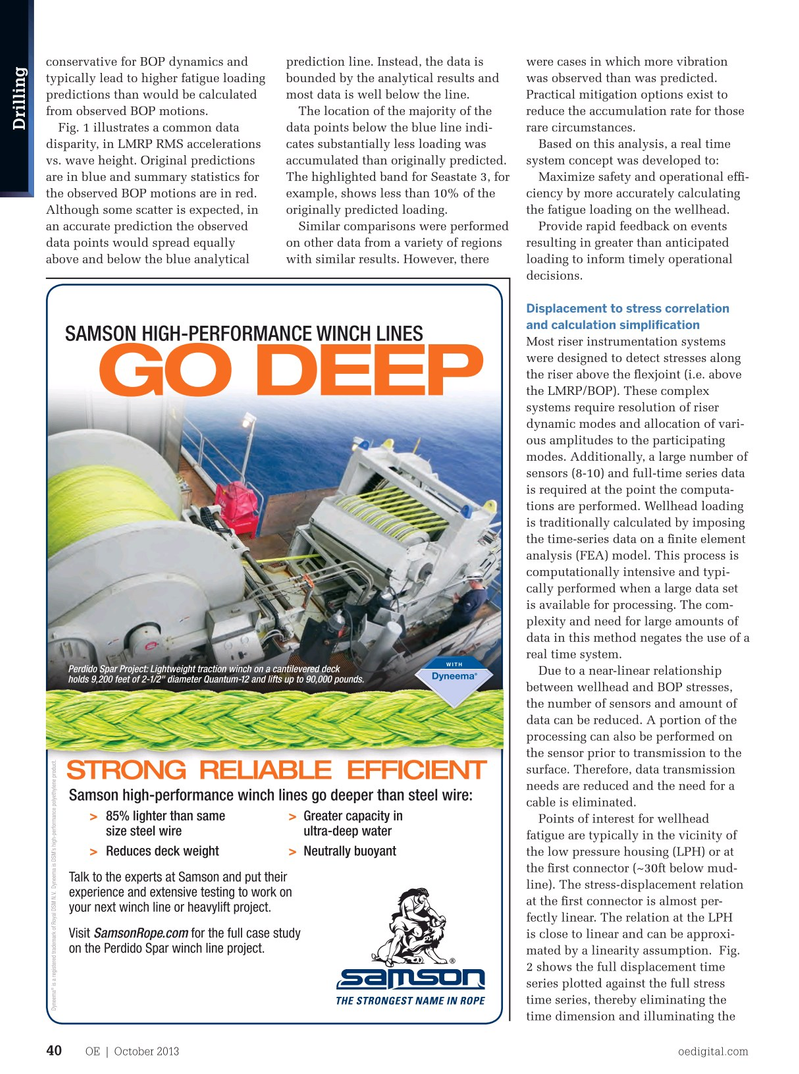
Page 38: of Offshore Engineer Magazine (Oct/Nov 2013)
Read this page in Pdf, Flash or Html5 edition of Oct/Nov 2013 Offshore Engineer Magazine
conservative for BOP dynamics and prediction line. Instead, the data is were cases in which more vibration typically lead to higher fatigue loading bounded by the analytical results and was observed than was predicted. predictions than would be calculated most data is well below the line. Practical mitigation options exist to from observed BOP motions. The location of the majority of the reduce the accumulation rate for those
Drilling
Fig. 1 illustrates a common data data points below the blue line indi- rare circumstances.
disparity, in LMRP RMS accelerations cates substantially less loading was Based on this analysis, a real time vs. wave height. Original predictions accumulated than originally predicted. system concept was developed to: are in blue and summary statistics for The highlighted band for Seastate 3, for Maximize safety and operational eff- the observed BOP motions are in red. example, shows less than 10% of the ciency by more accurately calculating
Although some scatter is expected, in originally predicted loading. the fatigue loading on the wellhead.
an accurate prediction the observed Similar comparisons were performed Provide rapid feedback on events data points would spread equally on other data from a variety of regions resulting in greater than anticipated above and below the blue analytical with similar results. However, there loading to inform timely operational decisions.
Displacement to stress correlation and calculation simplifcation
SamSon high-performance winch lineS
Most riser instrumentation systems were designed to detect stresses along the riser above the fexjoint (i.e. above the LMRP/BOP). These complex
GO DEEP systems require resolution of riser dynamic modes and allocation of vari- ous amplitudes to the participating modes. Additionally, a large number of sensors (8-10) and full-time series data is required at the point the computa- tions are performed. Wellhead loading is traditionally calculated by imposing the time-series data on a fnite element analysis (FEA) model. This process is computationally intensive and typi- cally performed when a large data set is available for processing. The com- plexity and need for large amounts of data in this method negates the use of a real time system.
Perdido Spar Project: Lightweight traction winch on a cantilevered deck
Due to a near-linear relationship holds 9,200 feet of 2-1/2" diameter Quantum-12 and lifts up to 90,000 pounds. between wellhead and BOP stresses, the number of sensors and amount of data can be reduced. A portion of the processing can also be performed on the sensor prior to transmission to the surface. Therefore, data transmission
STRONG RELIABLE EFFICIENT needs are reduced and the need for a
Samson high-performance winch lines go deeper than steel wire: cable is eliminated.
> 85% lighter than same > greater capacity in
Points of interest for wellhead size steel wire ultra-deep water fatigue are typically in the vicinity of > reduces deck weight > neutrally buoyant the low pressure housing (LPH) or at the frst connector (~30ft below mud-
Talk to the experts at Samson and put their line). The stress-displacement relation experience and extensive testing to work on at the frst connector is almost per- your next winch line or heavylift project. fectly linear. The relation at the LPH
Visit SamsonRope.com for the full case study is close to linear and can be approxi- on the Perdido Spar winch line project.
mated by a linearity assumption. Fig. 2 shows the full displacement time series plotted against the full stress ® time series, thereby eliminating the
Dyneema is a registered trademark of Royal DSM N.V. Dyneema is DSM’s high-performance polyethylene product.
time dimension and illuminating the
OE | October 2013 oedigital.com 40
OE1013_DC-2-BOP_v2.indd 40 9/29/13 9:25 PM

 37
37

 39
39